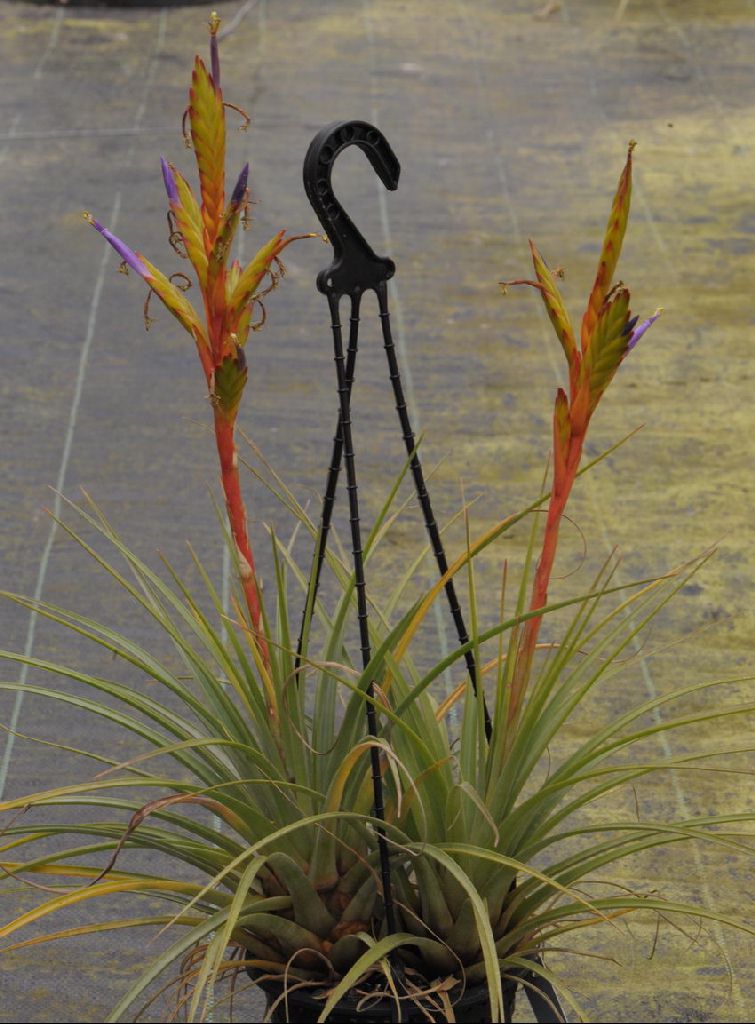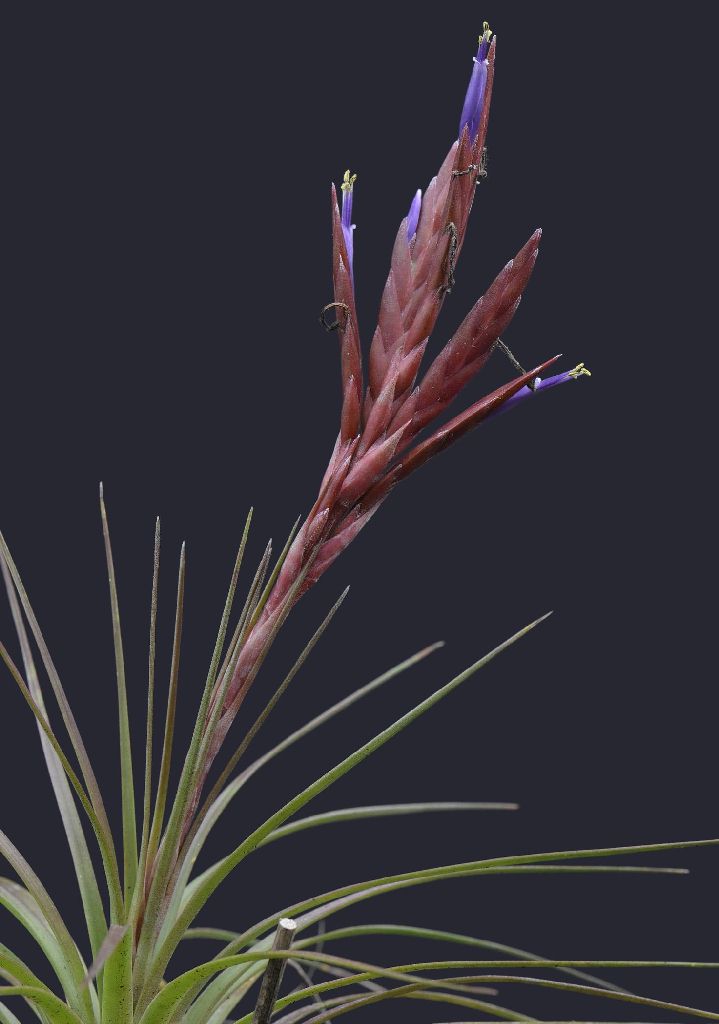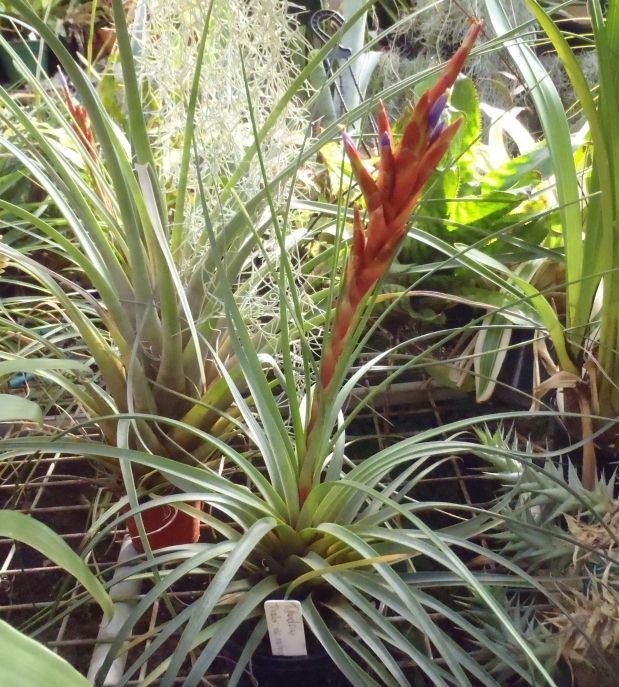


One group of plants where taxonomy has not been keeping up is the group we associate with T. tricolor. This includes T. tricolor var tricolor, T. tricolor var melanocrater ( now T. melanocrater) and T. tricolor var picta, all botanical varieties of T. tricolor. But recently there have been other related species newly described such as T. welzii & T. crista-gallii. Even though T. crista-gallii comes from Mexico, the type locality is almost on the Guatemalan border leading some to speculate that its habitat may cross over into Guatemala. T. crista-gallii as it is known locally in Mexico means cock’s comb and we have started calling these errant forms ‘Chook’ where they have a similar compound inflorescence where the short branches bend outwards, the floral bracts are red with scattered scales and the flowers are blue tubular with stamens exserted.
Here in Australia we see a range of forms of these T. tricolor-ish plants come into culture which have been close to the species T. crista-gallii, but we are unsure of their provenance or their actual identity. Hence we have coined the term ‘Chooks’ to deal with them. In all probability the name ‘Chooks’ will remain an Australasian phenomenon but will be put in the BCR so that there is a record of this/these plants identity.
Terry Davis - The photo above is another tillandsia out of Guatemala that was purchased as Tillandsia melanocrater but it grew quite larger and is similar if not the same as one that Chris Larson posted on Brom-L, and that Derek has called one of the 'Chooks'.
Chris Larson - The range of chooks that come in can be rather daunting. Before these species were described we only had the choices of T. ionantha var. melanocrater, & T. tricolor var picta – along with terms like aff & cf. Now we have T. crista-gallii, welzii, polystchia & a couple of others.
Chooks as a general term is what I thought was proposed. Chook as a specific term applying to a particular form is a new proposal to my ears (eyes). The trouble is which form to use as the “chook”/ T.Chook.
The T. tricolor var. melanocrater is very misunderstood in horticulture. Plants coming from Guatemala come in under this name – but what are they really? As they come through I don’t get to see them flower or get a chance to separate them – or even if I did, there has not been the taxonomic work done to separate the different plants coming through. Do I register every variant for it to disappear when the next lot comes in? Many collectors then tick off their lists when getting their “melanocrater” – but what have they really got? Most collectors don’t get that there are many plants that do not have names – not really fitting into the parameters of any species descriptions. They also don’t understand that different taxonomists put different emphasis on characteristics to come up with different answers. I love it when people look at me, upon hearing this, like I’m talking rubbish, so I say to call them what they like. These “melanocraters”, including the Chooks, are all in what I call the “T.tricolor group”
Peter Tristram - Many of us are Collector’s Corner Chook and Chook-a-like collectors. As you say, variety is endless, within a range of variable, but to name them all is a nightmare – impossible. I only have about 10 different lookers but I reckon some Punters will have dozens, after all of the TPEs and BSA, BSV, BSSA, BSQ, Bloomin Broms, conferences, and private sales. Great stuff!
It differs from T. tricolor in -
Leafblade twice as wide.
Inflorescence has many more spikes
Spikes have stem.
Flower bracts shorter instead of longer than the sepal.
Differs from T. polita in -
Offsets on long stolons
Inflorescence long cylindric.
Spike longer, more flowered.
Petals longer.
Differs from T. rodrigueziana in -
Plant greener and thinner leaves.
Offsets on long stolons.
Spike with stem.
Flower bracts longer, however, shorter than the sepals.
Sepals joined higher.
Petals longer.
Trip report:
On our Mexico trip in1988 we made a long stop at the pass of Buenos Aires on the route Motozindla to Tapazula. Mr Wulfinghoff from Pforzheim had reported to us a particularly fine undulating form of T. fuchsii he had discovered there, which we wanted to find. At the pass, we found a good parking spot on the edge of the soccer field of a small school. We were surprised by the diversity of the Tillandsias, which we saw very close on the trees. Except T. fuchsii we saw large clumps of a narrow undulating, looking pretty green plant. We thought it was like T. polita or T. rodrigueziana. But when we saw that the individual plants of the group connected with long stolons, and when we discovered that the leaves are much thinner and greener, we thought that it could perhaps be a new species.
We also had the luck, to discover a wonderfully coloured small plant with velvety leaves, which we had never seen before in Mexico. I remembered that you could buy this plant in Germany under the name T. brachycaulos var. multiflora, sometimes even in plant markets. But even we had never found this beauty. At home and after prolonged study I have noted that it is a separate species which is by no means a variety of T. brachycaulos. I have this plant, which is usually common in Guatemala, later described as T. velutina.
The plant with the stolon seemed also to be a good species, but we wanted to examine all aspects more exactly, so we went back to this area the next year. We stayed over-night in Motozindla. There were four hotels in the small town we selected Hotel Victoria in the Zocalo, which had rooms even with a warm water shower. It cost 18,000 Peso (= 7.50 EUR), such prices you can still dream about. And oh miracle, there was a Chinese restaurant, where we had excellent food for little money. The owner is particularly nice and gives us free the local newspaper. Before the food comes, I occupy myself by reading the newspaper. I could have done better. The paper was full with reports of raids and bandits.
Individual ranches in the area had been raided, cars and trucks on lonely side streets were robbed in an evil way. One report was particularly bad: A truck was broken into by a small band at dawn, to be in time for the start of the market in Motozindla. It was full of coffee workers and women who wanted to buy or sell at the market. The robbers plundered the whole cart, intimidated women were examined even in their most intimate areas, and all objects of value were taken off them.
Quite early in the morning, we drove to the pass of Buenos Aires and it took us a lot of time to explore the area. We went into a small Gorge and explored the opposite slope, but except for a group picture of small Catopsis we found only the same plants as on our trip in the previous year.
At the parking lot at the mini school I make herbarium specimens in the open car of T. velutina and the narrow leafed plant with stolons. Soon, we are surrounded by children, and Klaus gave them a small special performance in sleight of hand. He had a lot of little magical tricks, and nowhere, had he had so attentive viewers who were really amazed and rejoicing than the children in remote areas of Mexico. This knack comes after some time of being a teacher, and he declared that the plant I was working on should be called cresta de gallo, Cock’s comb, as it was known in the area. I answer that that is a really true and what better name could you have for the flowering state as it really describes the general shape.
I notice that I have a sunburn on my face, and eyes full of tears from the strong wind. So it is time that we drive off. The children wave goodbye. After some time, we see a signpost on a foot path: Bremen. Klaus is fascinated and says we must necessarily go this way (we have a cousin in Bremen, who has a coffee shop!). In Chiapas, there are so many coffee farms, operated by Germans. Klaus takes charge and we drive in the direction of Bremen. It is already afternoon, we have no idea how far it is to Bremen and whether it really is German, and whether there is accommodation. The sandy trail is getting worse, it is often a defile with high edges on both sides. I am thinking of the reports in the newspaper and I am sure that there was no strategically better opportunity for a bandit in such a place. As we travelled two hours and still no farm in sight, I'm forever nervous and want to necessarily reverse, Klaus however is to continue and there is the first argument on the trip. Finally I got through and we turn back. When we're back in civilisation, he thinks, “See, nothing happened!”
In the meantime, I was once again on the 13.3.1998 with Jurgen Lautner at the Paso Buenos Aires and have the plant number EM 981003. As we discovered at the Pass, we had perhaps not enough petrol in the tank for a trip to El Porvenir, Jurgen reversed again, to fill up in Motozindla. In the meantime the rest of us have a pleasant walk along the road. It's amazing how much more you can see, if you are walking! Directly on the trees next to the main road grew T. crista-gallii also terrestrially with many colorful T. guatemalensis and T. lampropoda. It's amazing that this new plant was not discovered already much earlier by any botanist who came this way.
-Well, after so much time has passed, the plant is to be finally published. They grow and thrive in my collection. After flowering they willingly produce many offsets and I have quite a few Tillandsia friends who will be happy.